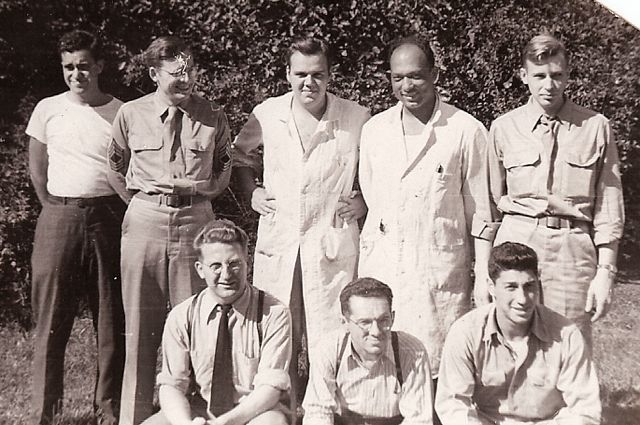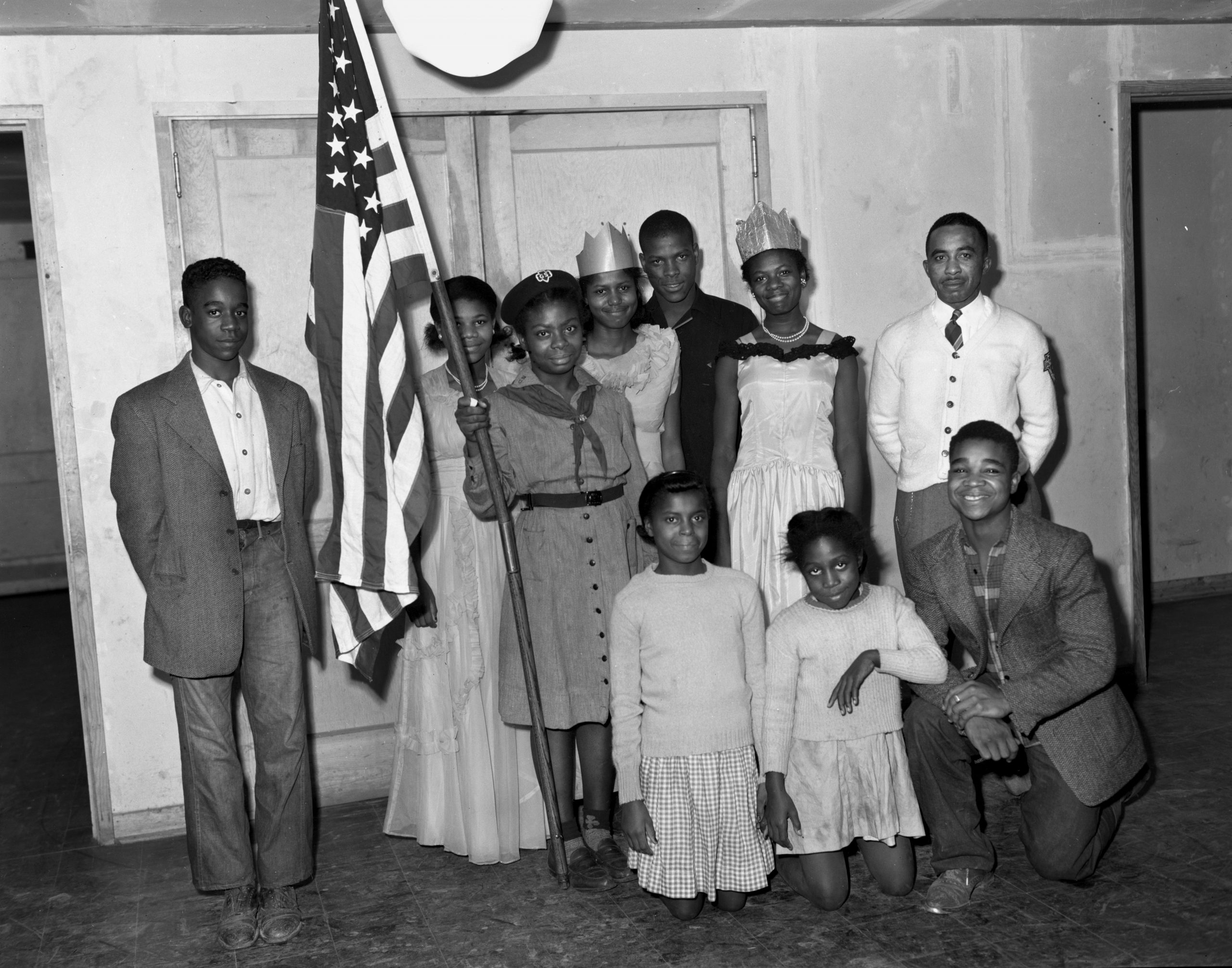African Americans played important, though often overlooked, roles on the Manhattan Project. Black workers, many striving to escape Jim Crow laws and the drought that devastated rural farming communities following the Great Depression, joined the project in the thousands. While some Black Manhattan Project workers were employed as scientists and technicians in Chicago and New York, most African Americans at Oak Ridge and Hanford were employed as construction workers, laborers, janitors, and domestic workers.
Black Americans and whites were united in their desire to contribute to the war effort. President Franklin D. Roosevelt’s Executive Order 8802, issued in 1941 after lobbying by A. Philip Randolph and other Black leaders, created greater employment opportunities for African Americans. It stated, “There shall be no discrimination in the employment of workers in defense industries of Government because of race, creed, color, or national origin.” To reinforce this executive order, a prohibition of discrimination clause was written into all defense contracts.
The prospect of higher-paying jobs and a better future drew many African Americans to the Manhattan Project. This does not mean that the Manhattan Project did not participate in racist practices such as segregation and unequal pay and housing, but federal work also offered many Black Americans an opportunity for advancement. The different Manhattan Project sites still adheared, for the most part, to the cultural expectations of the communities in which they were located. This means that the experience of African Americans on the project varied by individual, project site, and level of education.
Oak Ridge, TN
At Oak Ridge, segregation was pervasive and enforced, as it was throughout the South. Housing was segregated, and, because African Americans were generally only allowed to occupy the lowest paying jobs, lived in cramped “hutments.” Some white laborers also lived in the same type of hutments as well, but better paid whites were able to live in nicer accomidations. Initially, while African American men and women lived in the same general area, a five-foot fence with barbed wire across the top separated this housing from the rest of the community. Women lived inside a fenced area called the “Pen.” Guards were stationed outside the Pen for “protection” and to enforce a 10 o’clock curfew. Married couples were not allowed to live together. In addition, separate restrooms, drinking fountains, and dining and recreational facilities were the order of the day.
Army officials in Oak Ridge expected a population of only 2,500 but, as construction began, the population grew exponentially. As a result, the Army abandoned its plan to construct a “Negro Village;” a community for African Americans located at the east end of town. Though segregated from white housing, the complex would have been composed of the same type of homes and facilities. However, the influx of people into Oak Ridge was so great that the “East Village” became another white community. While white workers remained in hutments until 1945, many African American workers remained in the substandard hutments until 1950.
Seth Wheatley, who worked at the Y-12 Plant, vividly recalled an incident on a segregated bus:
On the way to Knoxville I happened to get on and sit in the last remaining seat, and a Negro was sitting there halfway back in the bus. Shortly after we started out, the bus driver noted that a black man was not sitting on the back row where he was supposed to be, and he stopped the bus along the side of the road. I can still see him getting up and walking back and almost grabbing the guy to make him get back to where he’s supposed to be. I had to get up to let him out, and it angered me very much, for my background. I went back to the back row with him and sat down with him.
Despite segregation, working at Oak Ridge offered many African Americans a chance to earn higher wages. Black laborers at Oak Ridge were offered an hourly wage of fifty-eight cents or more per hour, which was usually higher than what they could earn elsewhere in the South. Historian Valeria Steele quotes one Black resident of Oak Ridge: “Everybody was so glad to have a job making some money. We weren’t making money back home.”
Oak Ridge retained a strong Black community after the Manhattan Project. After the Supreme Court’s landmark 1954 Brown v. Board of Education decision, the city peacefully desegregated its junior high and high schools. Dunell Cohn remembered, “It was probably the first community in the South to honor that decision and in 1955 integrated the schools with no problems and no disruption. [However,] the elementary schools were not integrated until much later.”
Hanford, WA
The DuPont Company, the primary contractor for the Hanford Site, was instructed by the Manhattan Engineer District (MED) to construct facilities as quickly as possible. Between 1943-1945, DuPont extensively recruited Black workers. Approximately 15,000 African Americans, many leaving behind their family and friends in the South, arrived in the Tri-Cities (Richland, Kennewick, and Pasco). African American workers provided essential labor for building the facilities in which the plutonium for the “Fat Man” implosion bomb was produced.
Prior to the war, Kennewick, Pasco, and Richland were primarily farming communities. The Manhattan Project transformed the towns’ infrastructure and population. For example, the African American population of Pasco rose from 27 in 1940 to just under 1,000 in 1950. However, the MED ensured that African Americans never constituted more than 10-20% of the employees at Hanford. They deemed that range just enough to placate the Fair Employment Practices Committee’s requirements. Out of approximately 50,000 workers at Hanford in July 1944, roughly 10%, or 5,000, were African Americans.
Racism and segregation also accompanied these demographic changes and housing at Hanford was segregated. Unable to adequately accommodate the population surge, DuPont was only able to arrange for one barrack and one bunkhouse for “colored personnel” in Pasco, the only one of the Tri-Cities that allowed African American residents. Many Black workers lived in makeshift residences such as trailers, tents, and shacks.
“I’d never been around black people, and they had black people segregated from the whites,” recalled Lawrence Denton, a shipping clerk at Hanford. “That didn’t make sense to me. In the Christmas time when the postal department was overloaded, they took us clerks and asked us if we would deliver mail. I got the colored barracks. That confounded me more, why they segregated blacks and whites. But that was a fact.”
African Americans faced discrimination from businesses in Pasco. According to the NAACP’s E. R. Dudley, approximately 80% of restaurants, soda fountains, and lunch counters would not serve African Americans (Bauman). Law enforcement in Pasco also targeted Black residents. Police in Pasco created a crime called “investigation,” enabling officers to arrest African Americans without needing to charge them with any specific offense. 25% of arrests of African Americans in 1940s Pasco were for “investigation” (Bauman).
Many Black workers naturally developed sharply negative views of their time at Hanford. Lula Mae Little, a waitress who worked at the mess hall, referred to Hanford as the “Mississippi of the North.” Despite the experiences of racism that some endured, not all Black workers disliked their time in Hanford. Dining halls and sports teams were integrated and construction worker Luzell Johnson remembered, “I didn’t run into much racism at Hanford. Everybody was working together and eating together at the mess halls. Whites and colored could go in together and eat.”
Chicago Metallurgical Laboratory
A number of African American scientists worked on the Manhattan Project at the University of Chicago’s Met Lab. Ernest Wilkins and Ralph Gardner-Chavis assisted Enrico Fermi on plutonium research critical to the development of the production of fissionable nuclear materials. Jasper Jeffries, Benjamin Franklin Scott, and Moddie Taylor are among notable African American scientists who worked at the Met Lab. Wilkins and Jeffries signed the famous Szilard Petition, which urged President Truman to consider demonstrating the bomb before using it against Japan. In the image below, Jasper Jeffries is pictured in his lab coat with other workers from the Met Lab.

Los Alamos, NM
While African American scientists at the Chicago Met Lab and Columbia University contributed to the work of the Los Alamos laboratory, there are no records of African American scientists at Los Alamos during the Manhattan Project. However, a number of Black scientists did join Los Alamos National Laboratory after the war, and recalled an atmosphere of tolerance. In 1955, nuclear scientist George Johnson proclaimed, “In Los Alamos, I feel like I’m a real citizen.”
Columbia University
African Americans also worked on the Manhattan Project in New York City as scientists and technicians, although usually in subordinate positions within the lab. James Forde, hired as a lab assistant at the age of 17, worked at the Nash Garage Building, where scientists researched the gaseous diffusion process for separating uranium isotopes. He remembered, “You did clean-up work, you cleaned the beakers and other materials the scientists used. The main job I had was cleaning tubes in a sulfuric acid bath. I did not know what they were for…[When] I saw the headline where we had dropped the bomb, I said, ‘Oh, my God. That is what I was working on!’”
The Legacy of the Manhattan Project
The Manhattan Project reflected the era’s racism and segregation, but for many African Americans, it also represented opportunity. Despite the hardships, discrimination, and lack of the same upward mobility that their white counterparts may have been given, Black workers, technicians, and scientists were integral to the project. Their contributions, from the plants of Hanford and Oak Ridge to the laboratories of Chicago and Columbia, helped bring World War II to an end. Their experiences are an essential part of the Manhattan Project story.





